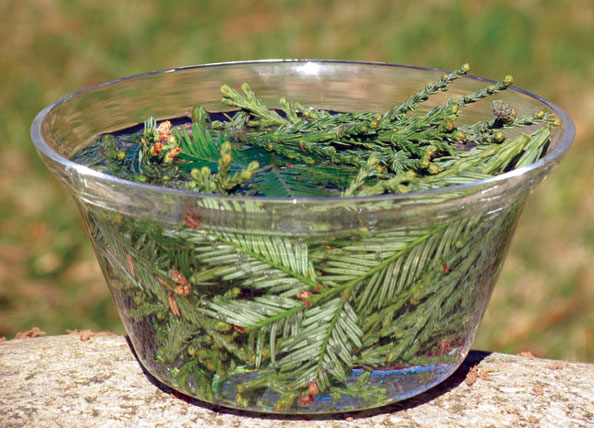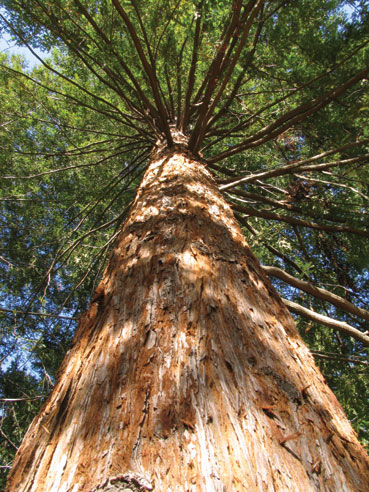An illustrative case history using the Redwood essence
Redwood trees are ancient giants, the tallest living beings on the Earth, reaching heights of up to 360 feet (100+ meters).
The contemporary Coast Redwood is Sequoia sempervirens. The species name is Latin meaning “forever living” or “forever green.” They are conifers (cone-bearing) gymnosperms (with “naked seeds”), like pines, firs and spruces, and keep their green needle leaves all year round. Coast Redwoods belong to the Taxodiaceae Plant Family, which also includes the two other surviving Redwood species: the Giant Sequoia, Sequoiadendron giganteum, found in the mid-elevations of the central Sierra Nevada mountains of California, and the Dawn Redwood, Metasequoia glyptostroboides , once thought to be extinct, but discovered in a remote Chinese valley in 1948.
The needles of the Redwood also reflect this polarity of dark below and light above. The lower needles are broad and long, breathing the moist cool air below.
Up in the sunlit crown of the Redwood, the needles grow short and narrow, resembling the needles of cedar or juniper. These leaves make their first appearance growing out of the bark of the upper branches. The scale-like upper leaves are well suited to the hotter, drier conditions found in the forest canopy.
The dense Redwood bark provides protection against the periodic fires that sweep through Redwood forests, often clearing out other trees and shrubs, leaving the singed Redwoods standing and ready to grow on for centuries more.
Redwoods flower during the late autumn or early winter, producing separate male and female flowers on the same tree. The pollen-producing male flowers appears as small yellowish-brown tufts at the end of the leaves, throughout the tree.
The greenish female flowers, the embryonic cones, appear only at the ends of the far upper branches of the tree.
Thus the Redwood relies on the updrafts to carry the pollen up to fertilize the flowers above. A mature Redwood tree can produce up to 100,000 tiny (3/4 - 1 inch / 2 cm) cones in a year, each producing around 100 seeds. Thus a single tree may produce as many as ten million seeds annually.
Although the Redwoods produce millions of seeds, few are fertile, and fewer still are able to produce viable seedlings. Those that do survive, however, are among the fastest growing trees in the world. They can often grow 30 feet (10 meters) in the first 20 years. New trees are often produced from sprouts which form at the enlarged base of the trunk.
These sprouts grow slowly, nourished by the root system and upper leaves of the “mother” tree. When the main tree dies, the sprouts are then free to grow as full trees, forming a “fairy ring” of trees around the stump of the initial tree. These trees in turn, may give rise to more sprouts, and the cycle continues. In that way some Redwoods may be the continuation of trees millions of years old.
During the past decade, Redwood researchers from Humboldt State University in Northern California have made some remarkable discoveries. Climbing more than 300 feet (100 meters) up into the ancient old growth Redwood forests, they have found a complete ecosystem of ferns, shrubs and whole trees growing high up in the forest canopy. These upper forest “epiphytes” include many fern species, and such trees and shrubs as Tanbark Oak, California Bay, Cascara, Sitka Spruce, Douglas Fir, Western Hemlock, Huckleberry, Salal, Elderberry and Gooseberry. Thus a whole ecosystem lives in the canopy of the Redwood forest, raised up to the light and warmth, high above the cool, damp mists of the forest floor.
For more information on redwood canopy ecology please see the following web site:
The Redwood flower essence is made from a combination of the male and female flowering twigs, thus embodying the polarity of the dark, moist world below, where only the male flowers are found, and the upper light-filled world in the forest canopy, where we find the female, cone-producing flowers.
We can feel in the Redwood essence the qualities of verticality and reaching upward for the light that we observe in the tree. This is a plant of tremendous physical vitality, rapid and massive growth, gravity-defying in its ability to lift water to the heights of its crown, and support not only its own abundant life, but the life of many other species. With its ability to lift matter from the dark density of the earth into the uplifted light-filled heights, the Redwood is a celebration of the stature and majesty of physical incarnation and creation. View more extraordinary images of Redwood trees on the website of Mario Vaden . Please read an illustrative case history using the Redwood essence. |

To install this Web App in your iPhone/iPad press ![]() and then Add to Home Screen.
and then Add to Home Screen.
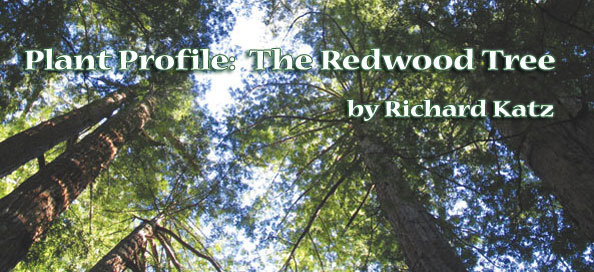
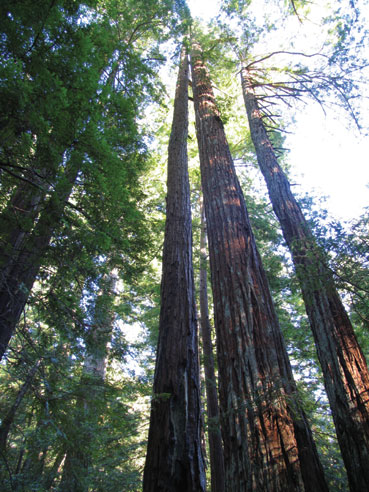 Redwoods are also known for their longevity, typically 500 – 1000 years, but sometimes more than 2000 years. Our contemporary Redwoods, however, are descendents from an even more ancient lineage. A hundred million years ago, in the age of dinosaurs, the primordial Redwoods were predominant in the forests of a much more moist and tropical North America. As the climate became drier and colder, the Redwoods retreated to a narrow strip along the Pacific coast of Northern California, where summer fog and mild winters contrast with harsher inland climates.
Redwoods are also known for their longevity, typically 500 – 1000 years, but sometimes more than 2000 years. Our contemporary Redwoods, however, are descendents from an even more ancient lineage. A hundred million years ago, in the age of dinosaurs, the primordial Redwoods were predominant in the forests of a much more moist and tropical North America. As the climate became drier and colder, the Redwoods retreated to a narrow strip along the Pacific coast of Northern California, where summer fog and mild winters contrast with harsher inland climates.
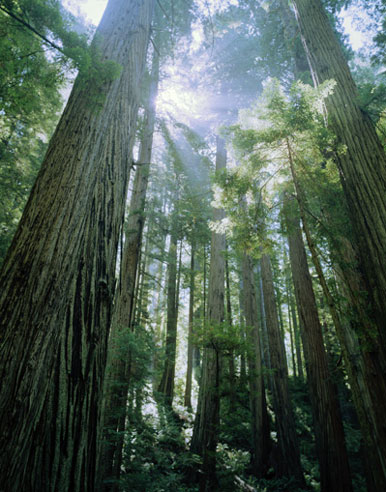 To walk into a Redwood forest is to enter nature’s cathedral. The Redwood needles form a dense mat on the forest floor, limiting understory plants and other tree growth, especially in a mature forest. The Redwood trunks reach upward, seeking the light far above the forest canopy, above the misty shroud below. In such an environment, it is not hard to imagine the misty primeval forests of old, when the Redwoods reached skyward to seek the pure light of the sun.
To walk into a Redwood forest is to enter nature’s cathedral. The Redwood needles form a dense mat on the forest floor, limiting understory plants and other tree growth, especially in a mature forest. The Redwood trunks reach upward, seeking the light far above the forest canopy, above the misty shroud below. In such an environment, it is not hard to imagine the misty primeval forests of old, when the Redwoods reached skyward to seek the pure light of the sun.
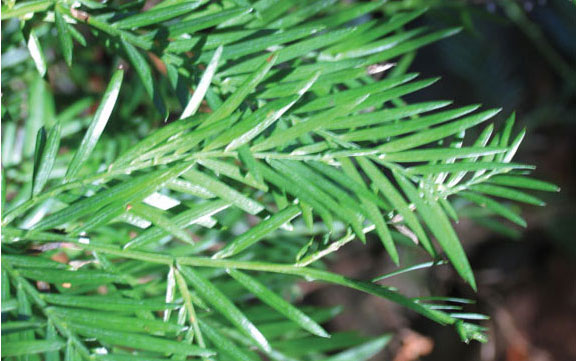
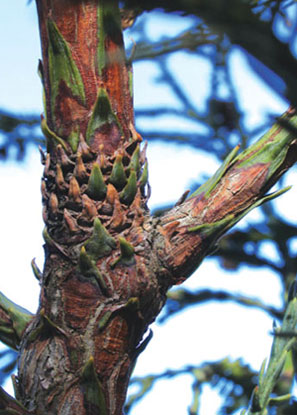
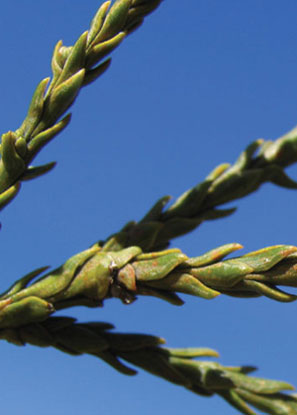
 Some of these fires can actually hollow out the lower interiors of the trunks, with little effect on the rest of the tree. As is typical of trees, the life of the Redwood is in the cambium under the bark. When a fire is intense enough to burn all the way around the cambium layer and kill the tree, its roots, buried in the cool, moist soil, often survive and send up new sprouts. With their shallow roots, often anchored in the roots of other trees, Redwoods are more susceptible to wind than fire, and can be toppled by fierce winter storms.
Some of these fires can actually hollow out the lower interiors of the trunks, with little effect on the rest of the tree. As is typical of trees, the life of the Redwood is in the cambium under the bark. When a fire is intense enough to burn all the way around the cambium layer and kill the tree, its roots, buried in the cool, moist soil, often survive and send up new sprouts. With their shallow roots, often anchored in the roots of other trees, Redwoods are more susceptible to wind than fire, and can be toppled by fierce winter storms.

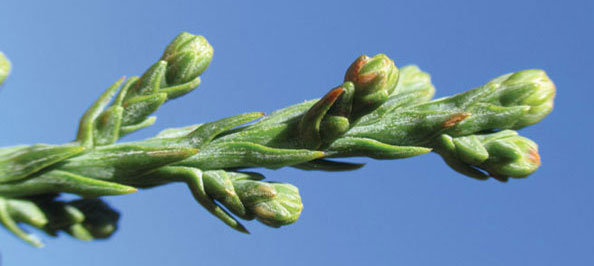

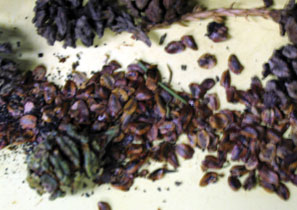

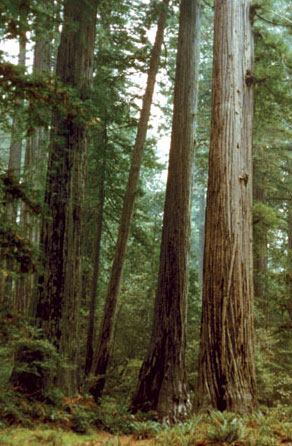
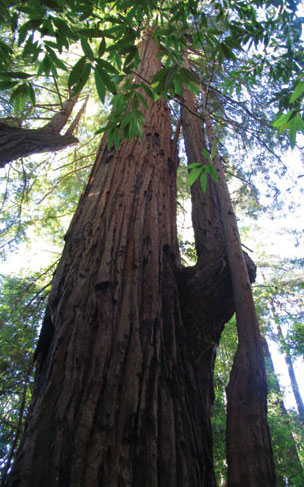 The dynamic life force of the Redwood is demonstrated in its ability to sprout whole trunks from the side of its main trunk. Although these “reiterated” trunks may originate high above the ground, they grow upright as if they were new trees. Dead foliage often collects at the base of these upper trunks, which becomes soil over the decades and centuries, forming an upper ground for other trees and shrubs to sprout and grow.
The dynamic life force of the Redwood is demonstrated in its ability to sprout whole trunks from the side of its main trunk. Although these “reiterated” trunks may originate high above the ground, they grow upright as if they were new trees. Dead foliage often collects at the base of these upper trunks, which becomes soil over the decades and centuries, forming an upper ground for other trees and shrubs to sprout and grow.
